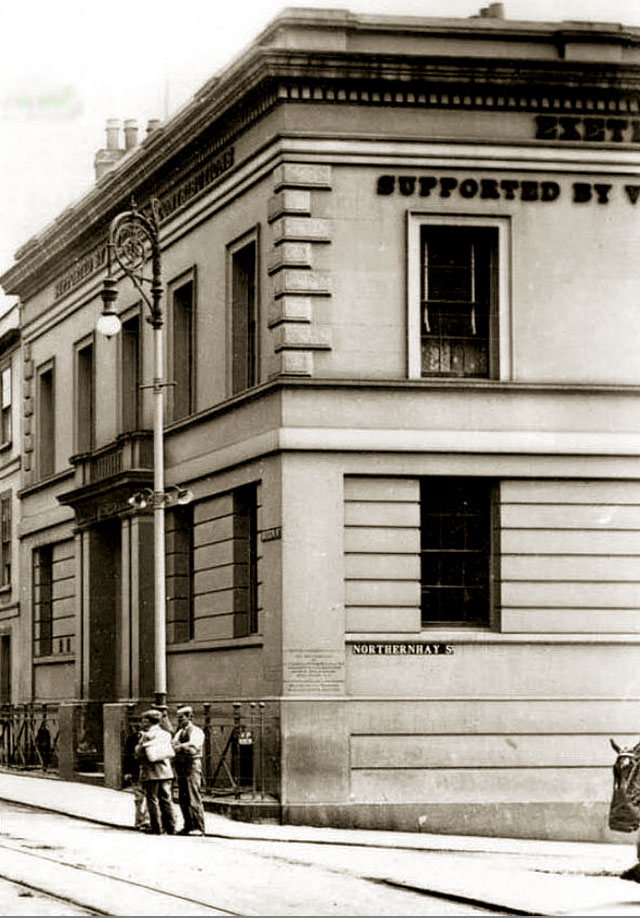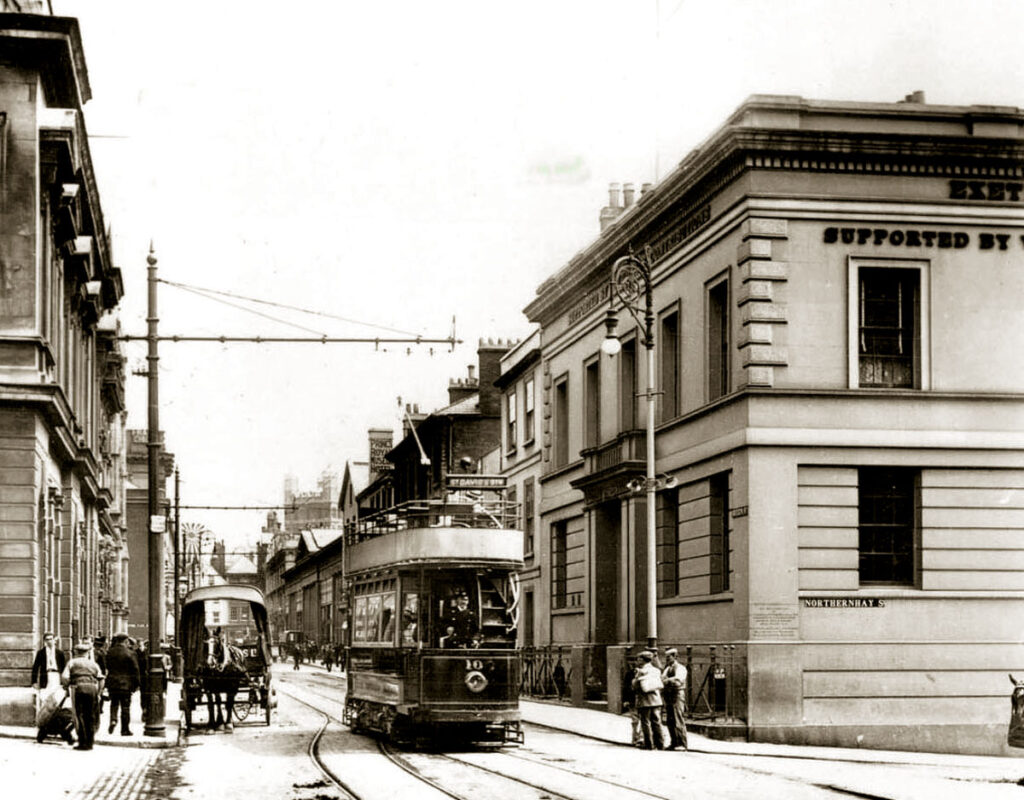Community researcher – David Radstone
The Exeter Dispensary, like voluntary Devon and Exeter Hospital, was a philanthropic establishment. Dispensaries initially differed from voluntary hospitals by not having wards or inpatient facilities. Early dispensaries provided outpatient care, including home visiting, and in many ways resembled modern health centres. Over time the Exeter Dispensary acquired inpatient facilities and operating theatres and was the largest charitable dispensary in Devon.
A model dispensary, to be provided by the State, was proposed by the national nineteenth century Poor Law Board (PLB). It was designed to care for the “sick poor” and limit outside relief paid by the Poor Law rates.The PLB specified “the indispensable requisites of a waiting room for patients, a dispensary room, and what is most essential for the proper working of the system, consulting rooms for the district medical officer”.
The PLB also specified that dispensaries were sited not more than a mile “and in most cases it should be much less, from the dwelling of any patient” and that there should be enough work to occupy a full-time dispenser.
The Exeter Dispensary was similar to the PLB model, but the funding was different and the medical staff were unpaid. Appointment as a honorary unpaid dispensary doctor gave status, allowing some dispensary doctors to enhance their private practices. The committee of the Exeter Dispensary recognised the voluntary service of the medical staff as when Dr Grainger retired in 1843: ‘Begs to record… his great humanity and indisputable talent, and to acknowledge with grateful feelings the disinterested services… rendered more than twenty-five years’.
The foundation of the Exeter Dispensary in 1818 was instigated by Dr. Henry Blackall who was a physician to the Devon and Exeter Hospital. On the 8th of January in 1818 the Exeter Flying Post recorded the event: ‘It must afford infinite satisfaction to every humane mind to be informed that a Dispensary is about to be established in this city for the gratuitous supply of medicine and professional advice to the indigent poor’.
The very first Medical Duty Rota of 31st January 1818 showed that a physician or a surgeon would attend patients at the Dispensary every day except Sunday.
The Exeter Dispensary was financed, like the Devon and Exeter Hospital founded 50 years earlier, not by Poor Law rates, or Provident Society membership, but by subscriptions. Subscribers had the right to recommend patients considered “proper objects”.
A subscriber to the Dispensary had to cough up half a guinea annually to recommend 2 patients, a subscriber to the Hospital had to pay one guinea to nominate one patient. The Dispensary also received donations. Thomas Woodman donated the prize of one guinea that he had won for the second best pig by the Agricultural Society. A donation of £2 was the surplus of the Grand Jury breakfast at the Devon Lammas Assizes.
The Dispensary was prepared to take patients that the Hospital would not. The constitution of the Devon and Exeter Hospital had rules limiting admissions, although those rules were not always followed: ‘That no Children under seven Years of Age (except in cases where an Operation is to be performed in the House); no Woman big with Child; no Persons disordered In their Senses, or suspected to have the Small-Pox, Itch, or any other infectious Disease; nor any that are apprehended to be in a Consumptive or Dying Condition; be admitted into the Hospital, as In-Patients, on any Account whatsoever’. Whereas the first General Meeting of the Dispensary in February 1818 resolved: ‘This charity is instituted for the purpose of affording relief to the Poor; particularly to persons suffering in Fevers, or contagious Diseases; and to children, when age or the nature of their complaint renders them unfit to be received into the Devon and Exeter Hospital’.
Accidents could be admitted as an emergency without a subscriber’s “ticket”. Only the “deserving poor” were admitted. People receiving Poor Law relief were not eligible for admission to the Exeter Dispensary, but would get outdoor relief or be admitted to a Poor Law workhouse infirmary. The Old City Hospital (now Heavitree Hospital) was formerly such a Poor Law workhouse infirmary.
The activity of the Exeter Dispensary was comparable to the Hospital and other provincial dispensaries in similar sized cities. The directory entries in Besley for 1828 and 1835 list the great and the good serving the first building in Friernhay Street. In 1828 Besley notes ‘the number of patients admitted since its establishment has been 8,556, of which 7,929 have been cured or relieved’. Woolmer in 1821 has a pithier entry ‘a public Dispensary was established by subscription in Friernhay Street, and is of incalculable benefit to the lower classes.’
Dr John Blackall (1771-1860), the great-grandson of Bishop Blackall, attended the Dispensary for most of his active life, whilst also being physician to the Wonford Hospital for Lunatics. Blackall was appointed by the Exeter Health Committee in 1831 to manage the cholera epidemic in Exeter, and reported the first case of cholera on 21st July 1832.
Dr. Peter Hennis, allegedly the last man killed in a duel, worked at the Dispensary throughout the epidemic. Dr John Blackall (1771-1860), the great-grandson of Bishop Blackall, attended the Dispensary for most of his active life, whilst also being physician to the Wonford Hospital for Lunatics. Blackall was appointed by the Exeter Health Committee in 1831 to manage the cholera epidemic in Exeter, and reported the first case of cholera on 21st July 1832. Dr. Peter Hennis, allegedly the last man killed in a duel, worked at the Dispensary throughout the epidemic.
Appointed Surgeon to the Dispensary in 1835, Thomas Shapter was also on the staff of the Devon and Exeter Hospital from 1847. He wrote the History of the Cholera in Exeter in 1847 and in 1848 inaugurated the Devon and Exeter Pathological Society with an address entitled ‘Medicine an art and its truths to be obtained’.
The Dispensary was much cheaper to run than the Devon and Exeter Hospital. It moved to a handsome building on Queen Street in 1840 and continued to treat the poor throughout the 1849 Cholera eruption.
The committee occasionally had staff problems. In 1905 the entire honorary (unpaid) medical staff threatened to strike over three issues. The first was that committee wanted to remove the list of their qualifications from the annual report. The second was that the doctors wanted an X-ray machine. The third was that they objected to the committee’s desire to appoint a salaried medical officer. The first complaint was resolved within a week. The X-ray equipment was rejected by the committee because the doctors also wanted their private patients to use the equipment. A salaried medical officer was not appointed and the honorary medical staff withdrew their threat.
At the same time the Dispensary committee was concerned by the large consumption of alcohol. They conducted a survey of alcohol use at other dispensaries and found that five times more alcohol was being consumed at the Exeter Dispensary than other institutions, although some of the other dispensaries were teetotal. It is not clear who was consuming the alcohol but this was brought to the attention of the medical staff!
The building in Queen Street is now part of Exeter College. The organisation lives on as the Exeter Dispensary Charity (www.exeterdispensary.org.uk) fulfilling the aims of the original Exeter Dispensary.

